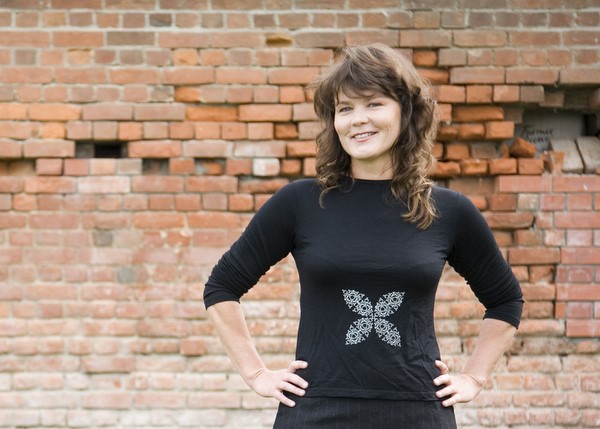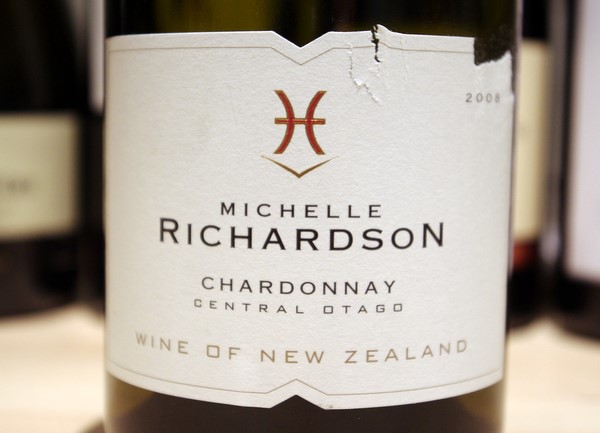|
Michelle
Richardson
An interview and tasting with one of New Zealand's leading
winemakers
Website:
www.richardsonwines.co.nz

Meeting
winemakers is one of the fun bits of my job. They're quite a diverse
bunch, ranging from the shy and retiring, to the opinionated and
forthright. Celebrated kiwi winemaker Michelle Richardson, who I met
over dinner at The Providores, falls firmly into the latter camp.
She was there to showcase two of the projects she is involved with:
Richardson wines, and also a new venture called Waitaki Braids.
Michelle's
wine career started at age 25 with a year's postgrduate course in
enology at Roseworthy in Australia. She'd previously spent three
years backpacking, after completing a degree in microbiology (1985).
'Yeasts got me into wine,' she says. But Gawler, the nearest town to
Roseworthy, wasn't exactly her favourite place. 'Thank god it was
just a year,' she says, noting that Gawler is largely populated by
ZZ Top fans and topless barmaids. And Roseworthy didn’t teach her
the important stuff: 'I still didn't know how to make wine,' she
says.
So it
was off to find a proper job. 'My Holden HQ couldn't make it to
Perth, but it got me to Port Macquarie,' she says, referring to her
first winemaking gig at the Cassegrain winery on the coast between
Sydney and Brisbane. 'I spent two years there and learned all the
practical bits about winemaking.'
This
was followed by a spell as a 'flying winemaker', working for Hugh
Ryman in Europe where her brief was to rock up at large wineries and
help them make consistent, clean, fruity wines for UK supermarkets.
But it was the next step that was to prove pivotal in her
development as a winemaker: in 1992 she did vintage at Villa Maria's
winery in Auckland. She was later hired by Villa’s owner, George
Fistonich, on a full time basis, and became chief winemaker here,
picking up a slew of awards for her wines.
'George
Fistonich gave me the ability to make wines how I wanted,’ says
Michelle. ‘He micromanages, but once he trusted me he let me do
what I wanted to. It was like a father-daughter relationship. I was
there 10 years and it was hard to leave, but I needed a challenge.'
So a few years back she left to start her own venture: Michelle
Richardson Wines. The relationship with George has been maintained,
and now she makes all her wines in the Villa Maria Auckland winery.
All the fruit is sent up to Auckland for processing.
Michelle
draws on Marlborough and Central Otago for her grapes.
Unsurprisingly, her Sauvignon Blanc is sourced from Marlborough. But
it's not designed to be a typical Marlborough Savvie. 'I wanted to
make a Sauvignon Blanc that I could finish the glass and have
another one.'
‘I
didn't want high alcohol. Lots of New Zealand aromatics are starting
to creep up in alcohol. I have decided that 13/13.5% is too high: I
want it at 12.5%. So I picked at 3 am at the Brix level that I
wanted. Consequently I was able to ferment to dryness. My secret is
that I keep a small portion back for natural ferment.’
Richardson
is adamant that 'wild ferments' aren't carried out by the yeasts
occurring in the vineyard. It is not vineyard yeast; it is winery
yeast,' she says. 'I know that for a fact.' She thinks that 20%
natural ferment is enough for Sauvignon, and that any more robs the
aroma. It takes away the Sauvignon Blanc aroma.
Chardonnay
is important to her. Initially she sourced it from Marlborough, but
now it comes from Central Otago. ‘My winemaking has changed since
I started out at Villa Maria,’ she reveals. ‘I thought when I
left that I'd keep making wines the same way, but when I had to buy
my own barrels, I changed my mind. They cost $1500. I only got one
new barrel, and I got it for free from a cooperage who thought I
still had influence.’
So
she used older barrels, and had what she described as a eureka
moment. ‘I wasn't a real fan of the Chardonnays I made before with
40% new oak. For me, I need something lighter. 5-10% new oak makes
the Chardonnay sing.’
‘Overoaked
Chardonnay has been why the ABC [anything but Chardonnay] movement
has arisen. I never lost the love for Chardonnay, but people were
just putting more oak into it. At Villa Maria I never had the
confidence to use less oak, but finances forced me to and I've never
looked back.’
For
Chardonnay she takes the wild ferment route. ‘I believe that
Chardonnay should be 100% wild ferment. I don't want peaches or
nectarines in my Chardonnay: it's not an aromatic!’
And
Michelle now believes that Central is the place to make Chardonnay;
after all, it does well with Pinot Noir, and the two tend to go
together. But Chardonnay from here hasn't been recognized as
serious. Michelle reckons that part of the problem is that clone 6
has been used as a workhorse; she uses Mendoza clone 15. She also
ferments warmer – cold ferments with commercial yeasts preserve
the tropical fruit notes, which she doesn't want.
‘Paramount
to me is the feel of the wine,’ says Michelle. ‘I am not
disregarding the nose – it is the introduction to the wine – but
how it rests in the mouth is really important. I would rob the wine
of a percentage of the aromatics for how it feels in the mouth.’
Now
she’s established as a well known winemaker, Michelle has opted
out of entering her wines into shows. ‘I got my winemaking
reputation through wine shows, but I wouldn't put my wines into wine
shows now. There are too many wines, and wines change so much when
you start to eat, especially Pinot Noir.’
She
adds that, ‘Some wines get left behind because they are subtle,
and they need food to show their best.’
Pinot
Noir is an important focus for her, and, again, wild ferments are an
important part of her approach. Her Pinot is sourced from Central
Otago, although she’s not a fan of all Central Pinots. ‘The
thing I didn't like about many Central Otago Pinot Noirs was that
the fruit tended to be jammy,’ she states. ‘What gave the jammy
character was the quick, efficient fermentation by cultured yeast.
The wine is made in a 5 day window: not the way it should happen
with Pinot Noir. It produces a lovely seductive sweet wine, which
seduces people, but I struggled with these big jammy wines. If you
use natural yeasts, it makes for a much more complex, interesting
wine.’

THE
WINES
Michelle
Richardson Sauvignon Blanc 2009 Marlborough, New Zealand
Quite dense and grassy with nice rounded fruit. A fresh wine
with nice presence and acidity. 88/100
Michelle
Richardson Chardonnay 2005 Marlborough
These days Michelle sources her Chardonnay from Central Otago,
but this older example is from Marlborough. Nutty, brioche nose is
aromatic and toasty, with nice citrus freshness. The palate is fresh
and spicy with some presence and good complexity. Just 8% new oak,
but it tastes like more. 92/100
Michelle
Richardson Chardonnay 2008 Central Otago
13.5% alcohol. Natural ferments, older oak. Very fine, complex,
refined Chardonnay. Subtle, integrated, gently nutty nose with fine
citrus, pear and white peach fruit. The palate is super-elegant and
fine with subtle mealiness and expressive fruit. No harshness here.
Lovely purity. Not overly concentrated but scores highly for
finesse. 94/100
Richardson
Pinot Noir 2006 Central Otago
Bright, fresh red cherry and red berry fruit nose. The palate is
fresh with rich cherry and berry fruit. Spicy and dense, but also
very fresh and youthful. Some grippy tannins on the finish, with a
bit of sweetness to the fruit. 92/100
See
also:
 Waitaki
Braids: new wines from a new region in New Zealand's north Otago Waitaki
Braids: new wines from a new region in New Zealand's north Otago
Wines
tasted 09/10
Find these wines with wine-searcher.com
Back
to top
|

